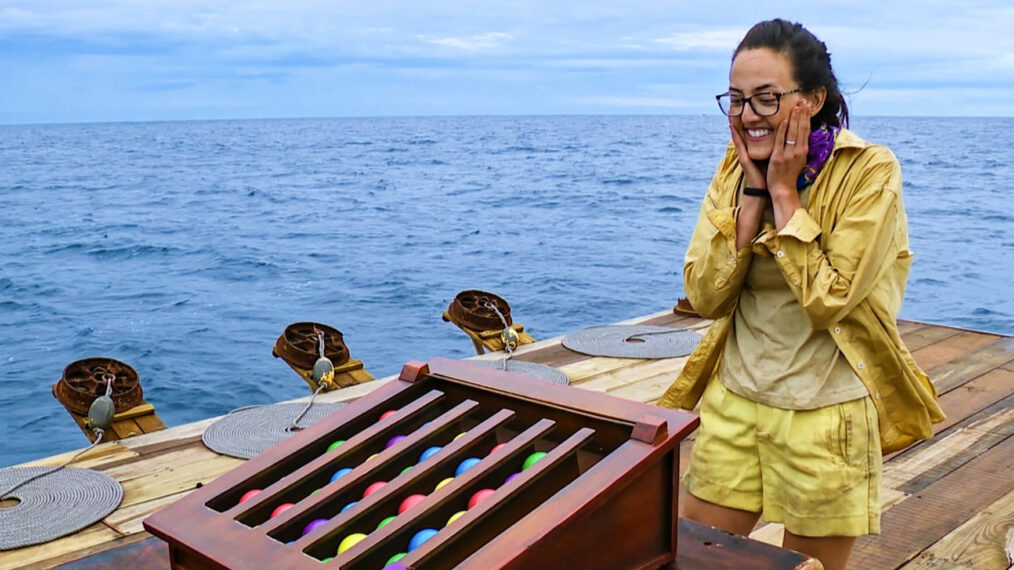‘Survivor’: Jeff Probst Breaks Down Every Detail of That New Weighted Timer

[Warning: The following contains MAJOR spoilers for Survivor Season 47 Episode 11, “Flip the Win Switch.”]
Survivor introduced a new journey challenge in Season 47 Episode 11 that featured a barge, anchors, and whole lot of rope. The new weighted timer was an exciting change to a challenge that would typically feature a standard sand timer. In the On Fire podcast (embedded below), Jeff Probst says the Survivor team felt that sand timers had become too boring and they wanted to challenge themselves to create something new, giving a detailed breakdown of this new journey’s creation in the process.
Rachel made it clear to her competitors that she wanted to go on this journey in the episode, which aired on Wednesday, November 27 on CBS. Lucky for her, she drew the rock that would send her on that solo mission. She was driven out via boat to a large barge in the middle of the water that had a small table with a puzzle on top of it. In the puzzle were five rows of balls of different colors. Rachel had to group each row by color before time ran out in order to claim her advantage prize. If she didn’t finish the puzzle in time, it would be hurtled into the ocean with the table, pulled underwater by the last of three anchors.
Three metal anchors were attached by long ropes. The time it took for the ropes to unspool and subsequently drop the anchors became the new timer. Probst revealed in On Fire that the person responsible for this new idea also suggested that Probst stab the rice bag in Season 45, a moment that went viral among Survivor fans.
The idea for the weighted timer “started where a lot of ideas start: with a question,” Probst told cohosts Charlie Davis and Jay Wolff. “And the question came from Matt. He’s in the editing bays, and he’s like ‘Sand timers work. They’re effective, but they’re not dramatic. There’s no urgency. You’re just waiting for the sand.’ Sometimes that’s really effective, but that was a question he posed to Team F.L.I.N.T. [an acronym for field, logistics, idols, notes, and twists, Team F.L.I.N.T. prepares the camp areas before the film crews and players arrive to the beaches]. How could we make a sand timer more dramatic? Well, Keoni Smith [shown in the TikTok video below], part of Team F.L.I.N.T., had the initial idea. Keoni was also the guy who had the idea for the knife into the bag of rice that I get credit for.”
@cbssurvivor Meet Andrea, Keoni, and Jimmy, members of Team F.L.I.N.T, an acronym for Field of Logistics Idols Notes and Twists! They’re responsible for getting everything set up for reality crews.✅ #Survivor #idols #twists #flint #crew ♬ original sound – Survivor
“He’s the one who first said, what if you had a barge in the middle of the ocean and there was a puzzle tied to a rope and the rope was tied to a boulder?” Probst continued. “And the simple premise is, before the player starts on the puzzle, they got to throw the boulder over the side and then the rope starts to unwind. And that unwinding rope is now your ticking clock. When the boulder finally sinks deep enough, it’s going to pull the rope, it’s attached to the puzzle. The puzzle will fly off the barge into the ocean. Great idea. But the key to a good idea is you must be able to execute it. Otherwise it’s just a bunch of words on a cocktail napkin.”
The host notes that they’re constantly coming up with new ideas to make Survivor exciting and fresh, but the ideas are “essentially worthless” until they figure out how to execute them in an entertaining and practical way.
Probst shares the process behind figuring out if this weighted timer would actually work: “Here’s how we typically approach these sand timers. You have to decide how long does the timer need to last? We have a basic idea on a challenge like this, the minimum amount of time we want it to last in order to have enough footage to actually edit it … We decided three minutes is about as short as we want it to go. So now you know that the average minimum amount of time it’s going to take the average person to solve this puzzle that we don’t have yet is going to be three minutes. So that’s our time. The next question becomes when we run this and we edit it, what is going to be the more interesting story? Is it going to be the puzzle, which it often is? Or in this case, might it be the ticking clock that’s most interesting?”
He continued: “Team F.L.I.N.T. wisely realized the more interesting story in the edit bays will be centered around the panic … that you’re going to feel with that rope unraveling. So that means now the timer is your story focus point. That’s the most interesting thing. So that means you want a puzzle that doesn’t have to be that interesting. It should be easy to understand, very easy to track because you don’t want to have to try to understand a complicated puzzle while feeling the panic of the rope.
“Enter Anthony Britten from the challenge department. He has this idea for the colored ball puzzle, which was a great idea because it’s really simple and you can make it easier or more difficult based on how you arrange the balls at the start. So Team F.L.I.N.T. tested several versions and found the sweet spot, had a lot of people play it. Dream Teamers, do it different. Somebody from accounting might try it. He gets it. OK, I got it in three minutes, roughly three minutes. So now we have the puzzle and we have the amount of time we need that timer to last. Now we bring in [the Marine team, who consult on water challenges].”
Literally testing the waters became the most important part of developing this journey. Expert scuba divers were tasked with finding “a spot in the ocean that takes three minutes for a really heavy weight to reach the bottom,” Probst explained. “The problem is that’s going to be a very deep part of the ocean. And anything we threw in, we’d never be able to get back. And we just don’t do that. We work very hard to leave locations better than we found them, so we’re not leaving any anchors on the ocean floor.” The team continued to troubleshoot from there.
“That informs Team Flint, OK, it’s going to require a few smaller weights and each weight will be responsible for a section of rope,” Probst added. “So Marine suggests, let’s use these old railroad tires that we use as moorings. They’re heavy and they have a really cool look and we get them locally in Fiji. They’re leftover from when Fiji used to ship sugarcane from the fields for export. But the key to all of this working was Henni Rall, who was the head of Marine having one simple idea. We’ll create a hinge that once one railroad tire pulls its section of rope taut, a pin will release from the hinge sending the next railroad tire into the ocean.”
Probst brags that Rachel’s challenge was filmed in one shot and there could be no do-overs, pointing out how Survivor stands out from the rest of reality competition shows. “Just think about all the unscripted shows you watch that might do a challenge like this. Go ahead, let ’em run through your head,” he said. “As they’re running through your head, try to think of even one that could possibly A) come up with this idea, B) figure out how to execute it, and then C) Do it. Actually pull it off in one shot real time. No do-overs. You’re not gonna find another show. I know that. This team is incredible.”
He adds that other details about how they created this new challenge are going to be kept secret. “There are a couple more elements that it took to actually make this work … I’m not going to share them because the ideas are so tiny but so smart that I consider them now part of our intellectual property. I mean it when I say I won’t share them with other shows. Trade secrets. I have friends that produce shows and sometimes they’ll ask me questions and I’m like, nope, not going to tell you how we get our audio. That’s our little secret.”
What did you think of this new solo challenge? Let us know in the comments section. And listen to the full On Fire podcast episode for free below.
Survivor, Wednesdays, 8/7c, CBS
From TV Guide Magazine
Crime, Comedy & Convenience Stores: Unwrapping Hulu's 'Deli Boys' With the Cast
Cupcakes, corndogs…and cocaine?! Two brothers find themselves in a hilarious pickle when they inherit an unseemly bodega biz in Hulu’s new comedy Deli Boys. Find out how The Sopranos and Real Housewives of Orange County influenced the cast. Read the story now on TV Insider.










